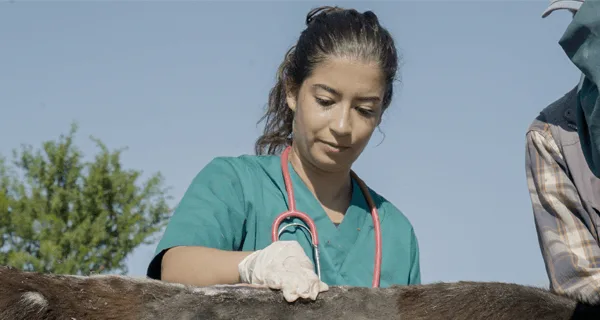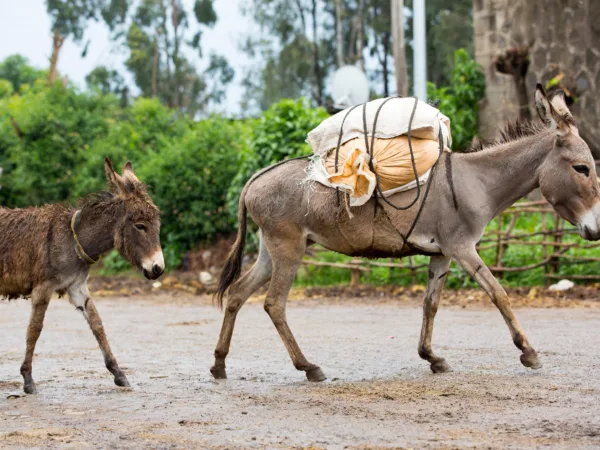Day in the life: Dr Hanna Zewdu, Ethiopia Project Leader
In SPANA’s ‘Day in the life’ series, we meet members of our staff across the world to find out about the highlights and challenges of their roles, working to improve the welfare of working animals. Today, we meet Dr Hanna Zewdu, SPANA vet and Ethiopia Project Leader, to learn about a typical day for her.
What is your job here at SPANA?
I am the SPANA Ethiopia Project Leader and work from our headquarters at Addis Ababa University College of Veterinary Medicine in Bishoftu. My job is to oversee all of SPANA veterinary, education and community training activities across the country. This involves everything from managing our veterinary projects to training staff. Some weeks, I will travel more than four hours to our mobile clinics in remote locations to supervise our team providing veterinary care to some of the most vulnerable donkeys and horses. It’s hard work, but I love the diversity of the job.
Tell me about a typical day working for SPANA?
I wake up at 5.00am and get my three children ready for school, packing their backpacks and preparing lunch. Then I have a breakfast of eggs and coffee, made in the traditional Ethiopian style, over a small flame. I catch a bus to the SPANA office, where I start work at 8:00am. We live in Bishoftu, which is located about 45km away from the capital city, Addis Ababa, and has a bustling market.
At work, I might be doing anything from overseeing a clinic treating horses with Epizootic lymphangitis (EZL) – a serious disease affecting up to 30 per cent of Ethiopia’s working equines, to speaking with our community trainers and education teams to make sure we are meeting our objectives and reaching as many people as possible with our animal welfare messaging. In a typical day, I will have meetings with staff here in Ethiopia, and in the UK, and manage teams of vets and teachers across our many locations – from Debre Brhan in the north to Shashemane in the south.
After a full day at work, I head home to have dinner with my family. I’ll help the kids with their homework and read a book, before it’s lights out. I need as much rest as I can get given how busy the days are!
How did you become a SPANA vet?
I have loved animals since I was a child. From an early age, I always knew that I wanted to become a vet. When I was in high school, I got a chance to visit a vet school, tour the facilities and learn more about what it takes to become a vet, which inspired me even more. While I was studying, I first heard about SPANA’s work, which sounded amazing, so in my summer holidays, I started volunteering with them. I graduated with a degree in veterinary medicine in 2010. After working at a vet college for a year, I heard that SPANA was looking to fill a veterinary vacancy and jumped at the opportunity! After seven years with SPANA, I became the Ethiopia Project Leader, and have been overseeing all SPANA activities for the last four years.
What is the hardest part of your job?
Every month, I travel with a team of vets, vet technicians and farriers to some of the more remote parts of Ethiopia to deliver mobile clinics. The travel is difficult, with hours spent driving on bumpy roads and working long and physically-gruelling hours. Due to the fact that some of the places we work are so rural, we often depend on government vet facilities to deliver SPANA’s free vet care. But in some places, we have really limited equipment like pens to handle more aggressive animals, so the job can be a dangerous one! Most equine patients are well-behaved, but a sick or scared animal can be unpredictable, so we have to be careful when providing treatment and take extra precautions to make sure SPANA staff are safe while on the job.
What is your favourite part of working with SPANA?
I enjoy working on all of SPANA’s projects and, as a vet, the treatment part of our work is especially close to my heart. However, a real highlight for me is seeing students react to our education programmes and welfare classes in schools. I love seeing young children’s faces light up as they learn more about developing empathy and compassion towards animals, while attending SPANA animal welfare clubs. I feel that we are contributing to the next generation of responsible and informed animal owners.
What is one thing you wish supporters knew about your job?
I would like supporters to know that their donations are being used directly to help address
so many working animal welfare issues here. I’m often struck by the fact that if we weren’t here to intervene, so many animals would suffer terribly. But thanks to SPANA supporters, we are directly improving the lives of working animals, while also promoting changes in attitudes and behaviour through our education and community training.
What would you like to see for the future of SPANA Ethiopia?
I’m very excited to see SPANA’s work in Ethiopia continue to grow and help even more working animals in need. I look forward to continuing to see communities increase their understanding and knowledge of animal welfare, while also seeing more schools incorporate our welfare courses into their curriculums. Ultimately, I’m hopeful to see a future where more of Ethiopia’s working animals are happy, healthy and well cared for.



